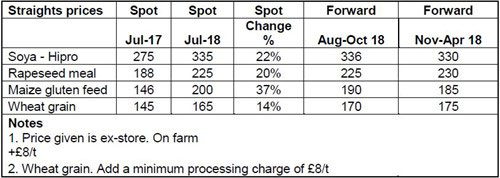



Forage Shortage Becoming Critical
UK - “The continuing dry weather is of great concern and for parts of the UK the forecast is for no rain for at least another 10 days,” says David Donaldson, National Nutritionist with The Dairy Group.He goes on to say, "Many of the herds we work with are feeding full ‘winter’ diets, which followed a long winter with many herds not turning out to grass until early May and in effect only benefiting from 6 weeks of good grazing. Yields of 1st cut have been variable and where 2nd cut has been made yields have been lower. Many herds are already feeding 1st cut and there are now concerns about the size of maize crop, especially where later drilled."
Grazing
For many there is no grazing for milking cows, but farmers should also consider grass availability for dry cows and for youngstock. Whilst grass will have a higher dry matter, the growth rate is now very low and may not support dry stock for much longer. The options are to buffer feed with round bales and to feed additional concentrates where needed.
Forage stocks & forward planning
There has never been a more important time to calculate forage stocks and to look at the forward requirements. Measure cubic metres of forage in each clamp & multiply by 0.6 to 0.7 tonnes (depending on the dry matter of the silage and the depth) to calculate the tonnes. Wet forages are denser than dry silage, so use the higher figure for wet grass silage. Wholecrop can be very dry and may only be 0.55 t per cubic metre. This will give the total fresh weight, but as important is the dry matter percentage. Account for any maize or other crops yet to be harvested. Try to estimate yield per hectare and number of hectares to work out fresh weight tonnage. Once the rain starts grass growth should be very rapid and this could help boost forage stocks later in the year.
Calculate the number of cows and youngstock to be fed from now until the expected turn out date in Spring 2019, to see if forage stocks are going to be sufficient. If forage stocks are not adequate it may be necessary to sell or cull some animals. Barren cows with low yields, lame or those with chronic mastitis are candidates for culling. Do not neglect the dry cows as lost weight in this period can be very damaging to milk yield, intakes, fertility and other health issues. Make sure that the far off dry cows have at least 90 MJ/day and if you can split the cows try to give the 3 weeks pre-calving at least 130 MJ/day. If you cannot split the group go half way and aim for 110 MJ/day. Straw is often a key component of transition diets, so weigh up carefully any cost saving with the potential downside from an inferior transition diet.
We use a ‘Forage Manager’ model based on kg dry matter to calculate the daily requirement for each group of animals and then to plan forward for the next 12 months. This helps to identify where there are gaps in supply and demand and then to consider alternative options.
Forage replacers & feed costs
Hay and straw are already very expensive this year ranging from £80 per tonne to double that in Cumbria and the South West. If maize harvest is early there could be an opportunity to plant Westerwolds which are high yielding and can be grazed from April onwards allowing maize to be planted in good time next spring. Those who grow cereals could consider stubble turnips, provided we do get rain for them to germinate. Stubble turnips can be a great feed for beef animals and youngstock on lighter land and could delay the need to house.
Cows need fibre to ensure a healthy rumen and to prevent acidosis, so if forage stocks are tight you may need to look at some forage replacers. Nutritionally Improved Straw (NIS pellets) are higher in energy than straw and provide a nice buffering action. Other products like sugar beet pulp and soya hulls are also great when fibre levels are low. Other products such as Trafford Gold, (50 per cent dry matter), when looked at on a dry matter basis can be good value and contain much higher energy and protein compared to hay and straw. Liquid products are fairly expensive on a dry matter basis, but if the diet is lacking in sugar or protein, can be cost effective for cattle.
Larger herds can cope with feeds like bread and brewers grains, but smaller units may not get across the face quickly enough to prevent mould growth. Consider feeds such as Palm Kernel, Sunflower, and Wheat Feed which are still reasonably priced and contain high fibre levels which could be an advantage with lower forage levels. Confectionary feeds can also be good value and contain more oil than the feeds mentioned above. This will increase their energy level, but be careful to not overfeed as high oil levels can lower butterfats.
Prices have risen this year as shown in the table below, with soya and rapeseed up by around 20 per cent and wheat by 14 per cent, which will feed through to increased compound feed prices this autumn and winter.

Impact on the cost of production
The exceptional weather is bound to result in increased costs with the increased price of straw & purchased feed and the additional purchases of silage, whole crop and forage replacers. Any reduction in milk output will also result in higher costs due to the loss of dilution of all overhead costs. A previous report by The Dairy Group anticipates an increase in the average cost of production of 10 per cent to 34.5ppl.
Reproduced by AHDB Dairy with kind permission from The Dairy Group
TheCattleSite News Desk



